The Ultimate List of Social Media Metrics (& Report Template)

Numbers speak louder than words. That’s a fact. But when it comes to social media, what facts can you bring up to prove that your social marketing strategy is working successfully? The answer lies in your ability to measure the results of your social media campaigns. As a digital marketing practitioner, you need to demonstrate the value of your work and continue growing as a social media marketing expert.
In this article, we’ll cover:
- Social media metrics that matter and their importance.
- The two major social media metrics groups.
- Dive into the peculiarities of measuring your results across the five most popular social media platforms.
- Share quick takeaways and a free social media metrics template to jump-start your social media campaign.
Are you ready to make a social media impression?
Table of contents:
- What Are Social Media Metrics?
- The importance of social media metrics
- Category #1: Social Media Engagement Metrics
- Metric #1: Amplification Rate
- Metric #2: Applause Rate
- Metric #3: Virality Rate
- Metric #4: Average Engagement Rate
- Category #2: Social Media Advertising Metrics
- Metric #1: Cost-per-click
- Metric #2: Click-through rate
- Metric #3: Bounce rate
- Metric #4: Return on investment (ROI)
- Category #3: Facebook Metrics
- Metric #1: Impressions
- Metric #3: Video Engagement
- Metric #4: Click-through Rate (CTR)
- Category #4: Instagram Metrics
- Metric #1: Impressions
- Metric #2: Reach
- Metric #3: Most Engaged Hashtags
- Metric #4: Discovery
- Category #5: Twitter Metrics
- Metric #1: Average Tweet Performance
- Metric #2: Audience Interests
- Metric #3: Engagement Rate
- Metric #4: Follower Growth
- Category #6: LinkedIn Metrics
- Metric #2: CTR (Click-Through Rate)
- Metric #3: Engagement Rate
- Metric #4: Employee Advocacy Analytics
- Category #7: YouTube Metrics
- Metric #1: Subscriber Count
- Metric #2: Impressions Click-Through Rate
- Metric #3: Engagement
- Metric #4: Watch Time
- Category #8: Negative Metrics
- Metric #1: Sentiment Analysis
- Metric #3: Unsubscribes/Unfollows
- Metric #4: Negative Reviews
- Download Our Free Social Media Metrics Template
- Now Over to You
What Are Social Media Metrics?
Social media metrics are the data used to assess the effectiveness of social media campaigns. This data analyzes the contribution of social media activity towards the overall marketing strategy and a company's revenue. These metrics help evaluate how successful you are in reaching your goals in the social space and provide insight to improve your social listening.
The importance of social media metrics
Social media metrics are essential because they are your Key Performance Indicators, or social media KPIs, in evaluating the effectiveness of your overall strategy. Tracking these metrics helps you validate your strategic decisions and improve your cross-departmental collaboration, for example, with sales. Additionally, keeping an eye on social media metrics will allow you:
- To demonstrate how your work has impacted revenue.
- To define your social media conversion rate that can be attributed to your online campaigns.
- To learn about your audience. Metrics in social media can paint a vivid profile picture of your online followers. Social media monitoring your performance online will help you shed some light on what types of content your prospects and clients prefer.
- Impact brand awareness. A company's online presence is directly related to its authority and recognition.
- Set goals and act fast. If something doesn't prove to be working, regroup and start over. Doing so will help you get the desired number of followers to enter your sales funnel.
You want to make important marketing decisions based on data and evidence, not vanity metrics. When it comes to social media management, what are the most important social media metrics? Let’s take a deeper dive into the first category of social media metrics to track.
Category #1: Social Media Engagement Metrics
Users interact differently across all social media platforms. However, most of those interactions can be grouped as a number of engagements—likes, shares, reposts, replies, and reactions.
If your content is engaging, it means your audience is taking a moment to interact with your content. And that is praiseworthy not just because you've done a fantastic job at disrupting users' mindless scrolling. It's also imperative because such content gets an extra authority score from algorithms. That, in turn, leads to a higher post reach and boosted website traffic.
But like most metrics, considering only one engagement metric doesn’t provide the context you need to make informed decisions for your social media strategy. Let’s take a look at the four most important social media engagement metrics that can make a splash when it comes to tracking.
- Amplification Rate
- Applause Rate
- Virality Rate
- Average Engagement Rate
While monitoring one social media metric can help you make quick improvements and earn easy wins, getting a panoramic view is essential for any digital marketing campaign. Looking at the whole picture is great as you're devising your strategy, but keeping a close eye on one metric in particular can really help you be more agile and quickly pivot your strategy.
Metric #1: Amplification Rate
The amplification rate measures the ratio of social shares per post to the total number of your followers. This rate measures your content’s popularity and represents how much your online audience wants to be associated with your brand. The amplification rate can be calculated by dividing the total number of shares your post has generated by total followers, then multiplied by 100.
Metric #2: Applause Rate
The applause rate could be compared to a virtual nod in agreement, a “yeah, I like that!” exclamation, a digital sign of approval. This helps you understand what percentage of your audience finds your content valuable. As you can imagine, this knowledge can go a long way towards helping you develop a content marketing plan and strengthen your social share of voice. To calculate the applause rate, combine the number of approval actions your post got over time and divide it by the total number of your followers. After that, multiply the result by 100.
Metric #3: Virality Rate
Going viral is the ultimate business goal. If you have a business presence on social media, going viral can expand your sales pipeline and boost conversions. You can calculate the virality rate by dividing the number of post shares by the number of impressions, then multiplying by 100.
Metric #4: Average Engagement Rate
The average engagement rate is an important metric. Your average engagement rate demonstrates if your content reaches your audience and gets their attention through likes, shares, and comments. To calculate your engagement rate, divide the total number of likes, shares, and comments your post has accumulated by the total number of followers and multiply by 100.
Now that we’ve established the standard metrics for online social media engagement, we will explore another important group of metrics—social media advertising.
Category #2: Social Media Advertising Metrics
For online advertisers, tracking social media performance isn’t just about staying with the budget. Understanding and correctly interpreting the data adds to your digital marketing expertise. It will ultimately improve your social media advertising strategy so you can increase your fan base, your net promoter score, and your business through the power of social media marketing.
- Cost per click (CPC)
- Click-through rate (CTR)
- Bounce rate
- Return on investment (ROI)
Tracking each of these beautiful metrics can make a big difference for your project. And once mastered, you’ll get all the confidence to steer your digital marketing ship in the right direction.
Metric #1: Cost-per-click
Cost per click (CPC) is a metric that shows how much each click on an ad costs. Advertisers widely use cost per click with a set daily budget for a campaign. Some publishers determine their ad rates based on a formula: the cost per impression (CPI) divided by the percent click-through ratio (%CTR). Other publishers use a bidding process to establish their rates. Most publishers use a third party to match them with advertisers. The largest third-party entity that most publishers work with is Google Ads, which uses a platform called Google AdSense.
Metric #2: Click-through rate
Click-through-rate (CTR) is a conversion metric that tracks how many people click your content or ad to be directed to a landing page with the additional information. In the case of social media advertising, it is to complete a conversion. If your CTR's are low, it's a tell-tale sign that your content is not resonating with your target audience.
Metric #3: Bounce rate
Bounce rate is the percentage of page visitors who exited your online page as soon as they'd landed on it, without taking any action.
Bounce rate allows you to measure your social traffic compared with other online traffic sources to determine the effectiveness of your digital campaign. The best way to track and optimize your bounce rate is through Google Analytics.
Metric #4: Return on investment (ROI)
ROIs can differ significantly depending on the industry. When it comes to social media, you need to know if the time and money you've spent on your digital campaigns were worth the hard work. Exactly how you calculate ROI will be determined by your organization’s objectives (brand awareness, brand mentions, revenue, customer satisfaction, etc.).
To give you some idea, here’s a simple formula to calculate ROI for social media: Value/investment (people hours, ad budget, etc.) X 100 = social media ROI (as a percentage).
Unless you are blessed with a dedicated social media team, monitoring and analyzing the above social metrics is plenty to inform your social strategy. However, you need to understand how each social platform works when dissecting its most important metrics.
Category #3: Facebook Metrics
Facebook is plentiful of data. Why? According to Statista, 2.8 billion people get on Facebook every single day to scroll through the feed, share their updates, or look through some suggested content about what they may like.
{Graph}
- Impressions
- Reach
- Video Engagement
- Click-through Rate (CTR)
If you want to grow your online presence and attract more prospects, Facebook is the platform you don’t want to skip. We’ve selected four of the essential metrics marketers keep an eye on.
Metric #1: Impressions
Impressions are Facebook’s metric that tells you about your social posts’ visibility or how many times your content has been seen.
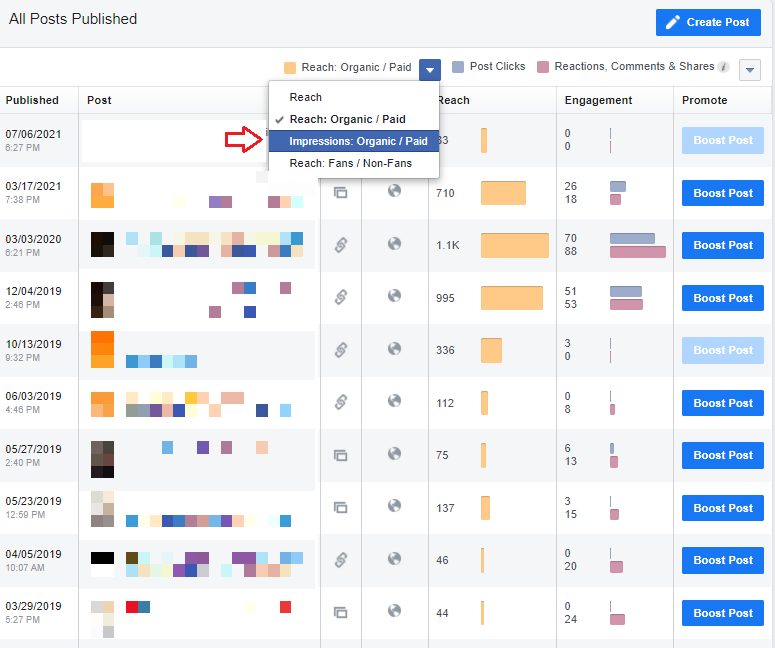
To find this metric:
- Go to your Facebook business page.
- Locate the "Insights" button on your "Manage page" sidebar.
- Click the "Posts" button located on the left sidebar of the screen.
- Go to "Reach: Organic/Paid" and switch to "Impressions: Organic/Paid".
Metric #2: Reach
A post’s social media reach represents the total number of unique users who have seen your content or a paid ad. This metric tells you how your content resonates with your audience to help you improve your digital strategy based on the data.
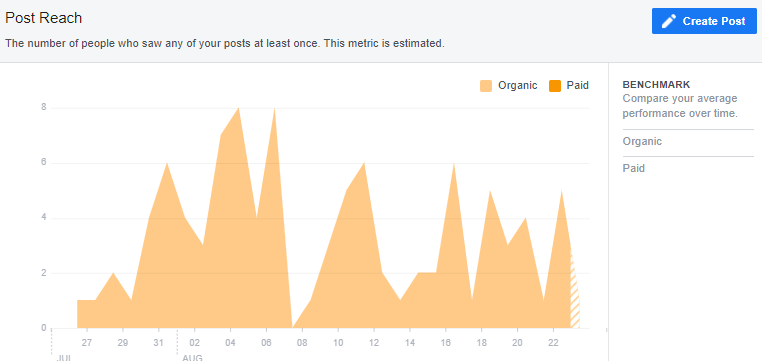
To find this metric:
- Locate the “Insights” button from your “Manage page” sidebar on your Facebook business page.
- Click the “Reach” button on the left sidebar of the screen.
Metric #3: Video Engagement
Video engagement, or clicks to play, is calculated based on the number of likes, shares, comments, and clicks generated by your video content. Facebook offers two ways to analyze your data” for an individual video or your videos’ overall performance.
Metric #4: Click-through Rate (CTR)
Click-through rate (CTR) shows the percentage of people who have seen your ad, clicked it, and went to your landing page. The average CTR on Facebook is around 1%. If Facebook sees that your ads are driving impressions but not clocks, it presumes your content to be irrelevant to your audience. This can negatively affect your post’s overall performance and lead to paying more per click.
Keep these metrics in mind when creating content for your Facebook followers. Let’s talk about the metrics of another social media giant that can significantly impact your company’s branding.
Category #4: Instagram Metrics
Just like with any other social media platform used for business, if you are not tracking your results—you are wasting your resources. Whether you are looking into collaboration with an influencer or track your own account performance, below are the metrics of utmost importance.
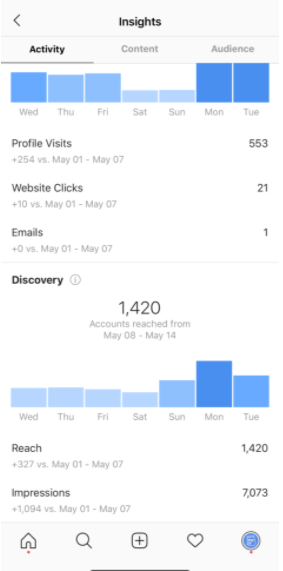
- Impressions
- Reach
- Most Engaged Hashtags
- Discovery
While no one would doubt the importance of tracking these stats (that’s why they are right up front), there’s much more valuable intelligence to be gleaned by doing a deeper dive.
Metric #1: Impressions
Impressions are the number of times your post was shown to your audience. Instagram social media analytics further breaks down this data by showing the impressions that came from hashtags, from home, or profiles. Good hashtag use will help improve your post impressions.
Metric #2: Reach
Reach is the number of users who saw your post. You can view this metric within your Instagram Insights.
Metric #3: Most Engaged Hashtags
Another tried and trusted way to increase your reach is with the help of hashtags and branded hashtags. By using relevant industry hashtags, you can help keep reach and engagement in check.
Instagram users can add up to 30 hashtags on each post, but do your research and testing before settling on a specific number of hashtags. You may be surprised by how often less is more when it comes to hashtags.
Metric #4: Discovery
Discovery is Instagram's feature that allows users to find fresh, interesting content from accounts they haven't followed yet. Instagram’s insights will display the number of users reached who are not currently following you.
Its triumphant launch back in 2014 marked a steady move toward greater transparency and social media measurement abilities for all its users. Ever since then, it has continued to impress the digital world. Which social media platform are we referring to? It's Twitter, of course.
Category #5: Twitter Metrics
Twitter is renowned for its quick and easy way of communicating. And it has over 328 million active monthly users.
So, including it in your social media strategy is logical. But once your ads are on, you might trip over the amount of social analytics data. It can get overwhelming to make sense of it all. We've put together a quick collection of the most important metrics to track to help you navigate the sea of analytics data and optimize your Twitter campaigns.
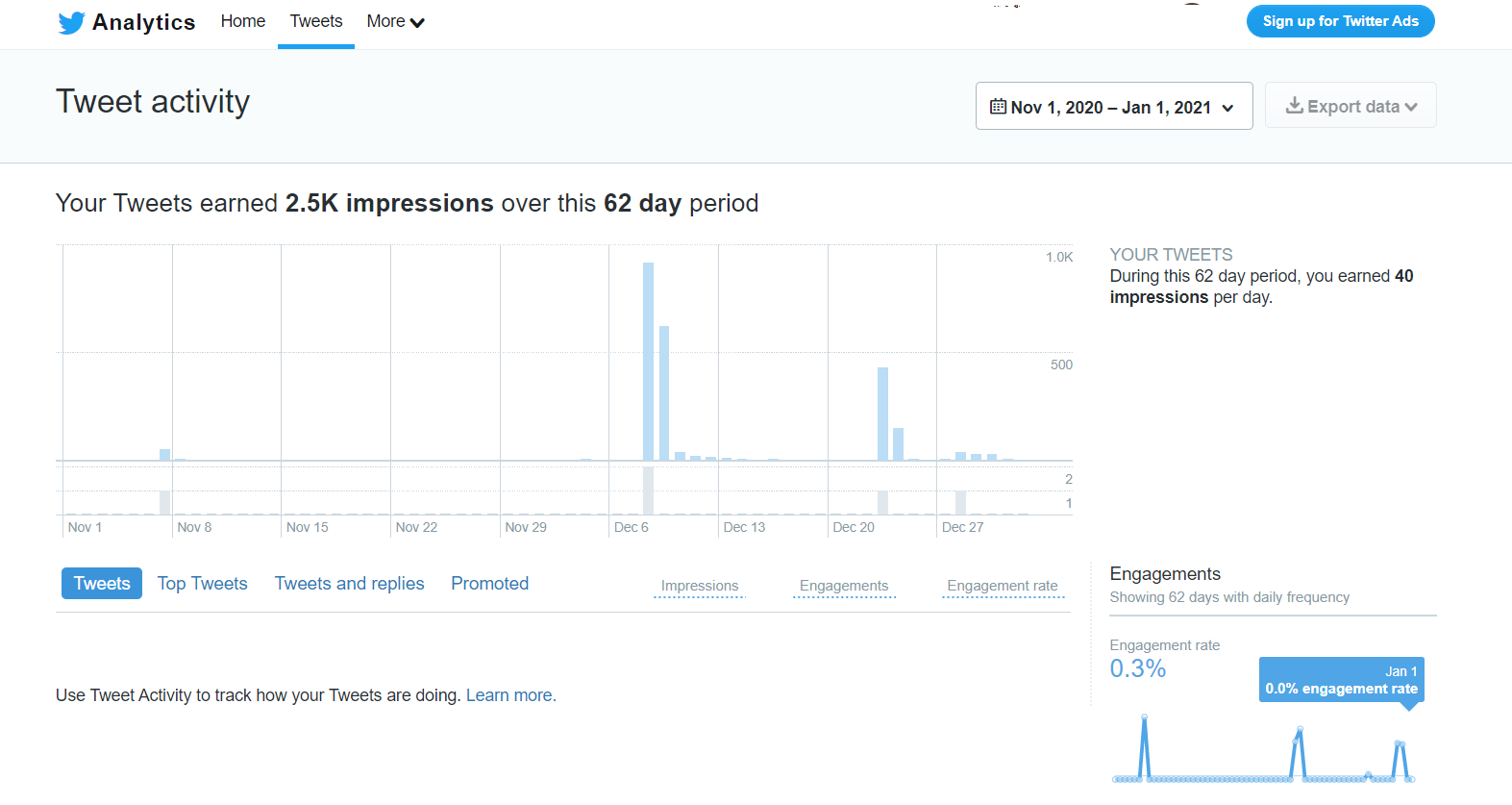
- Average Tweet Performance
- Audience Interests
- Engagement Rate
- Follower Growth
Now, let’s get into the nitty-gritty of most essential Twitter metrics to track.
Metric #1: Average Tweet Performance
When it comes to measuring Twitter metrics, begin by estimating the averages.
If you calculate your average engagement rate, average shares, and average retweet number, you can smooth over the fluctuations in your performance. To check your average performance, simply go to your Tweets page on your Twitter analytics dashboard.
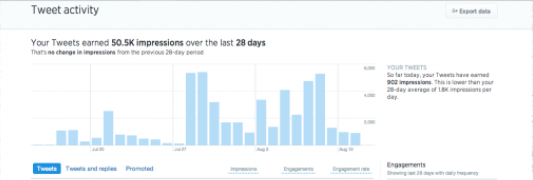
Metric #2: Audience Interests
Social media is called social for a reason. Part of being social implies knowing who your followers are. Twitter audience metrics that show the type of audience member your page is attracting are integral for future campaigns. Your audience insights give you a comprehensive overview of who you should be crafting your messages for. Besides, what should the content of those messages be?
This data will ensure you’re producing relevant content for the right audience based on important demographics such as their interests, location, gender, and lifestyle choices.

However, monitor these insights over a period of time, as they may change as your brand develops.
Metric #3: Engagement Rate
If your business has an account on Twitter, it absolutely must be tracking its engagement results. Engagement rate is an overview metric. Analyzing this data will tell you if your social media efforts are paying off. And the beautiful thing about it is that there are myriads of ways for your followers to engage with your brand.
For example, when someone clicks on a link, follows you, retweets, or uses your branded hashtag.
There's a lot more to unravel, so to find your overall engagement rate, navigate to your Tweets dashboard on Twitter Analytics and click on Engagement Rate.
Metric #4: Follower Growth
Every online brand needs its loyal followers. But if those loyal ones aren't growing in their number, your sales will be dipping. The bigger the audience, the broader the reach. Hence, more chances of making a successful sale.
With Twitter analytics, you can monitor how quickly and effectively your number of followers is growing. Your social media report can include your performance on a weekly basis, starting from day one.
Keeping a close eye on your follower count can help you stay proactive with response time to a sensitive tweet before it gets out of control. Yet, if you still need to make a business case to expand your social media presence, it adds to your arguments in favor of it.
For our next social media platform, there should be no reason to advocate for it. It’s the place to be when it comes to representing your business and its people.
Category #6: LinkedIn Metrics
Tracking LinkedIn analytics is essential for quantifying your social media marketing efforts and providing the data you need to improve your social media ROI and reach your social media goals.
LinkedIn has changed dramatically over the years and became the go-to social network for B2B brands. It's the platform to find top-tier talent and show off your industry influence.
In fact, a whopping 79% of marketers say that this platform is a prime source of lead generation.
- Impressions
- CTR (Click-Through Rate)
- Engagement Rate
- Employee Advocacy Analytics
However, leveraging the powers of LinkedIn to the fullest requires a strategy that's different from what works on Facebook, Instagram, or Twitter.
Content standards on LinkedIn are a lot higher, demanding it to be more professional and perfected. But that's not the only thing that's peculiar about it. The platform also relies on a unique set of metrics.

When reviewing the updated metrics chart, you can gain additional social media insights. For instance, determine the best time to publish based on the times and dates your social media posts are seen more often and refine your posting schedule. Additionally, what LinkedIn posts to sponsor based on what type of social media content is the most engaging. Besides, viewing your social impressions over time allows you to stay agile and quickly update your overall marketing strategy.
But there's a catch. A high number of impressions doesn't indicate that you can sit back and relax. You still need to look at the following three metrics to understand if your post resonated with your audience.
Metric #2: CTR (Click-Through Rate)

LinkedIn counts clicks when a signed-in member clicks on your post, company name, or logo. Interactions such as shares, reactions, or comments are not included in this metric.
CTR is an actionable metric that provides you with a panoramic picture of your post's engagement. It is a metric displayed as a percentage that divides the number of clicks your post receives by the number of impressions.
Metric #3: Engagement Rate

LinkedIn measures engagement rate by adding the number of interactions, clicks, and new followers acquired, divided by the post's impressions. A high engagement rate speaks volumes about the relevancy and quality of your content.
The higher the engagement rate, the more compelling your audience finds your content.
Metric #4: Employee Advocacy Analytics
Your team members are your brand ambassadors. And if your company takes good care of your employees, it’s going to show. On their LinkedIn Help page, they say that employee advocacy analytics presents an opportunity for page admins to assess trends in how employees and members interact with content suggested to employees on the My Company tab. The data includes such metrics as the number of recommendations and referrals made for the people connected to your company's LinkedIn page. Or the number of user comments on employee posts.
As we are making our way to the end of the list of social media platforms, we’d be remiss if we didn’t mention the platform that allows spreading the love for video and musical content.
Category #7: YouTube Metrics
To be successful on YouTube, one needs to know the recipe for a successful video. In part, this means understanding the subscriber count, watch time, audience reach, retention, click-through rate, and traffic source.
If you’d like to grow your YouTube channel, here are the four most important metrics to track your audience growth rate.
- Subscriber Count
- Impressions Click-Through Rate
- Engagement
- Watch Time
Every day people upload more than 700,000 hours of video on YouTube, but few of those videos drive users' interest. To be able to measure your brand's YouTube success, you must understand metrics within YouTube Analytics.
Metric #1: Subscriber Count
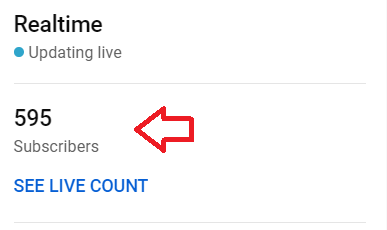
A subscriber gets notified about new content on your social media channel, making it easier for them to consume your videos and increase your view count. Subscribers tend to watch twice as much video content as regular viewers.
The subscribers gained and lost metrics speak for themselves, allowing you to interpret which videos, locations, and time frames gain and lose subscribers. YouTube's Subscriber Report shows you the status of your subscribers' list after every video, allowing you to understand which videos attract new subscribers. By prioritizing your subscribers' interests, like creating custom webinars, you'll create videos they want to see, increase your watch time, and boost your search engine rankings.
Metric #2: Impressions Click-Through Rate
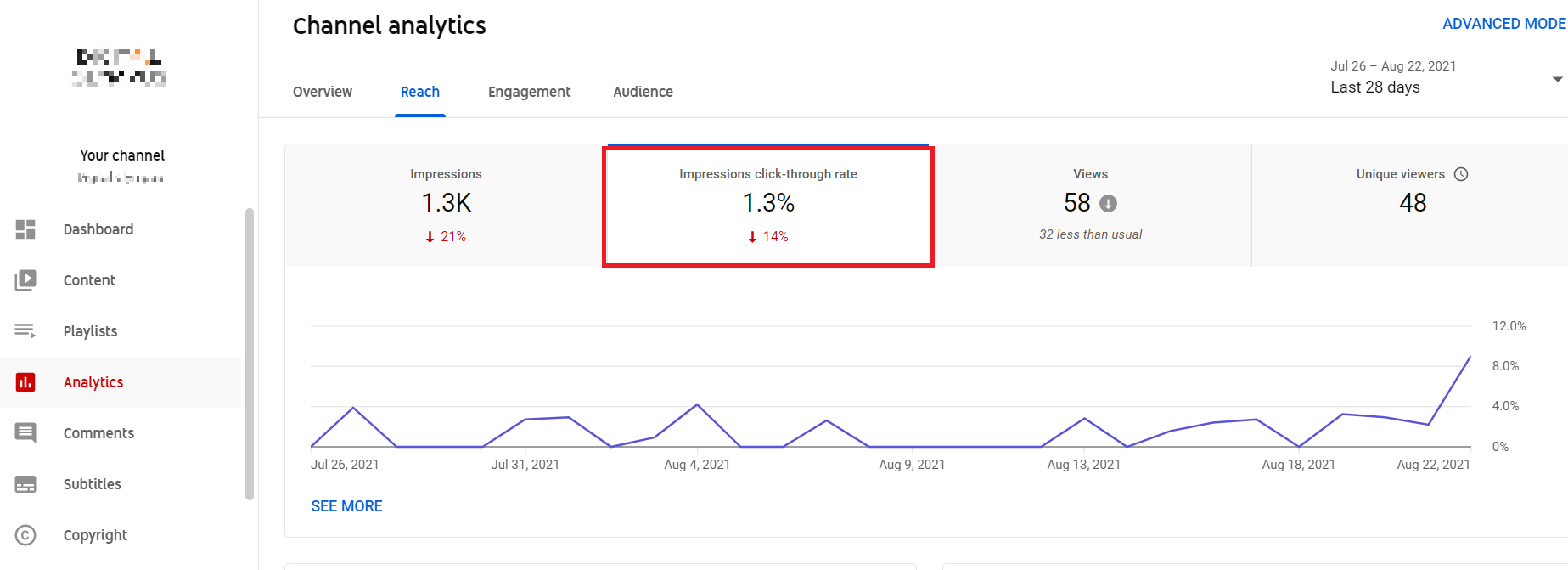
The impressions click-through rate tells you how often users click on your video. It quantifies your impressions into views. Similar to a Facebook ad, for every set number of people who saw your video in their feed, a certain number clicked on it.
How to get your followers to click? Many factors are at play: it's the eye-catching title of the video or a thumbnail with the right information on it.
Understanding impressions’ click-through rates inevitably leads to standing out. Use these findings to optimize your marketing collateral, update your channel's logos and other branding elements according to the viewers' likes.
Metric #3: Engagement
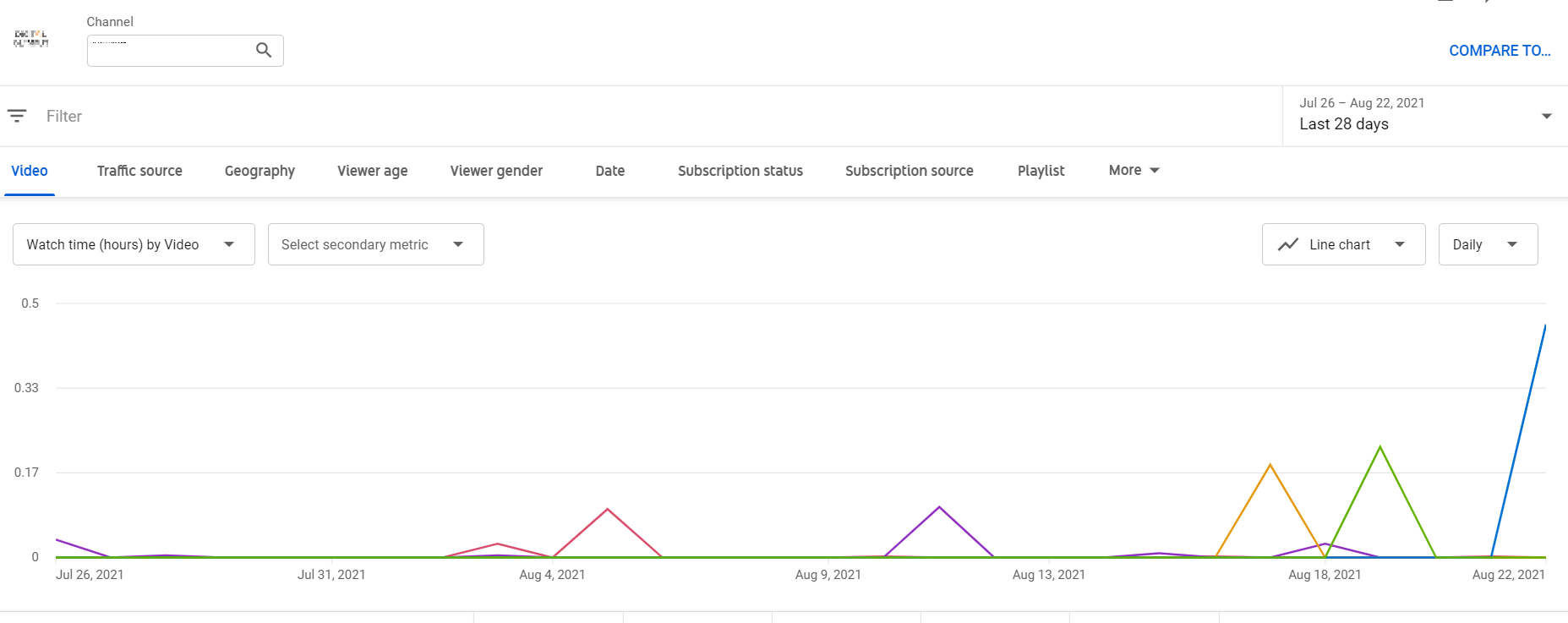
Likes, dislikes, comments, and shares give marketers invaluable qualitative data on engagement.
Shares confirm that people publicly display their trust and support and want to pass it along to their online network.
Comments can demonstrate the intensity of viewers' emotions after watching your video. Likes and dislikes can help you conclude what video topics work best with your particular audience. To find your videos' engagement metrics, navigate to YouTube's Interactions Report.
Metric #4: Watch Time
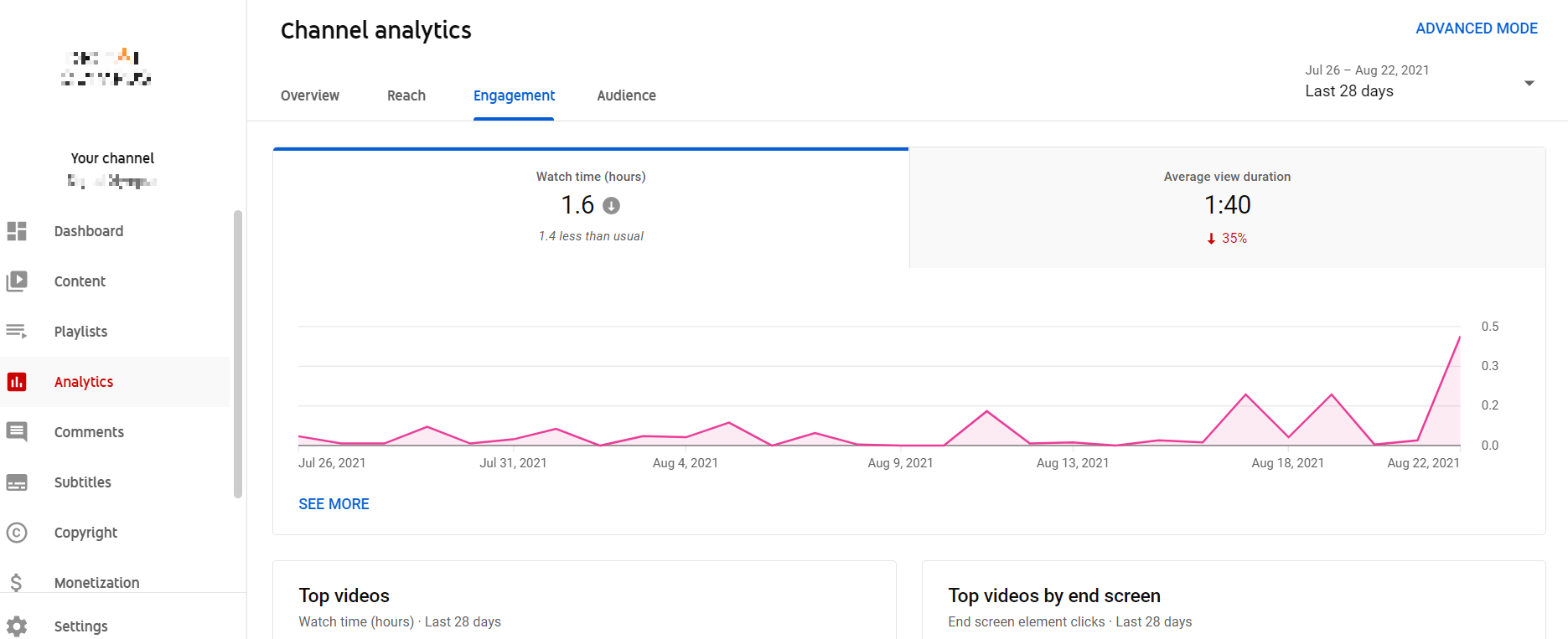
The YouTube watch time metric shows the accrual of time people have spent watching it. It is a fundamental metric to track because watch time plays a significant role in the YouTube algorithm. Videos with higher watch time get prioritized to appear at the top of YouTube search results and recommendations, bringing the new potential audience to your channel. The algorithm assumes that the more views a video gets, the more useful and engaging it is.
You can easily find this metric in the watch time report. It'll show you the amount of watch time your videos have accumulated over time. You can also filter each of your videos by watch time and group your videos by topics, styles, and lengths to determine your most engaging types of videos.
Category #8: Negative Metrics
Even though these metrics are called negative, it doesn’t mean you need to stay away from tracking them. On the contrary, one needs to remain alert about any changes in these four metrics:
- Sentiment Analysis
- Churn Rate
- Unsubscribes/Unfollows
- Negative Reviews
These four negative social media metrics may not be very encouraging or motivating to report on. However, they can quickly bring up the red flags about your social media campaigns and the potential adjustments that need to be made.
Metric #1: Sentiment Analysis
Information is power when it comes to what people say about your brand. Social media sentiment is the collective feelings, opinions, and emotions that people have toward your brand on social media. It is the objective interpretation of what all the comments, @-mentions, and shares present.
To figure out where your brand stands on the spectrum of positive or negative emotions, you need to analyze this number of conversions. Sentiment analysis requires collecting and analyzing information in the posts people share about your brand on social media.
Sentiment analysis is important because it gets you closer to understanding your audience, improving the customer journey, customer service, and customer engagement, along with product development. The best way to approach conducting such analysis is with the help of a special social media analytics tool.
Metric #2: Churn Rate
Churn rate, also known as customer churn or attrition rate, is the percentage of customers who stop doing business with a company over some time.
Every industry has its own churn rate benchmark. To calculate your churn rate, take the number of clients you lost last quarter and divide that by the number of new logos that signed up. The resulting percentage is your churn rate. For instance, a company that started last quarter with 500 customers and lost ten would have a churn rate of 2%.
Metric #3: Unsubscribes/Unfollows
Having a large following on a social channel is amazing, but they are useless in bringing you profit unless they engage with your content. Naturally, unengaged users will begin to drop off your follower or subscriber list. Clearly, there will be some attrition. However, it's essential to understand why your followers leave to help you acquire new ones. One of the best ways to help you improve your unsubscribe or unfollow rates is to ask your audience what type of content they like to receive, how often, and in what form.
Metric #4: Negative Reviews
When negative customer reviews are posted online, the entire world can see them. Bad word of mouth travels fast, and it can profoundly impact your brand's reputation. Sadly, there's nothing you can do to stop someone from posting negative feedback about your business. However, there is a right way to address negative reviews to take back control of your reputation. Among those things are a prompt and careful response, taking that conversation offline, and providing some positive testimonials on your site.
When you provide an appropriate (and quick) response to negative reviews, you demonstrate to both your clients and prospects the type of experience they can expect to get from your brand. That's the right way to be social across those media platforms that were developed for it.
Download Our Free Social Media Metrics Template
Tracking important social media metrics is necessary to know what's going on with your brand's online presence and communicate this information across other teams. To help you catalyze your social media strategy, we’ve developed this handy social media metrics report template.
An established way to monitor and report on your online performance will streamline your work processes and make them work like clockwork.
Now Over to You
Monitoring and tracking your brand's social media success, or lack thereof, can become overwhelming. Yet, the bottom line is that hard work always pays off. If you know how to track social media metrics, you control your social media strategy.
We hope the definitions of social media metrics we shared were easy to remember, and the importance of tracking those metrics—clear and concise. Not only will you be able to substantiate your KPIs, but you will also work to improve your overall social media strategy and evolve as a digital marketing professional at your organization.
There are a lot of social media platforms, but the most popular ones—Facebook, Instagram, Twitter, LinkedIn, and YouTube—are the ones your business must be present on. But remember, even though all those platforms are called social media, they all require an individual approach to interpreting their data.
We hope our template will help you jump-start your journey to tracking social media metrics. And just in case, our blog is a great resource for inspiration and finding answers to your most burning digital marketing questions.









